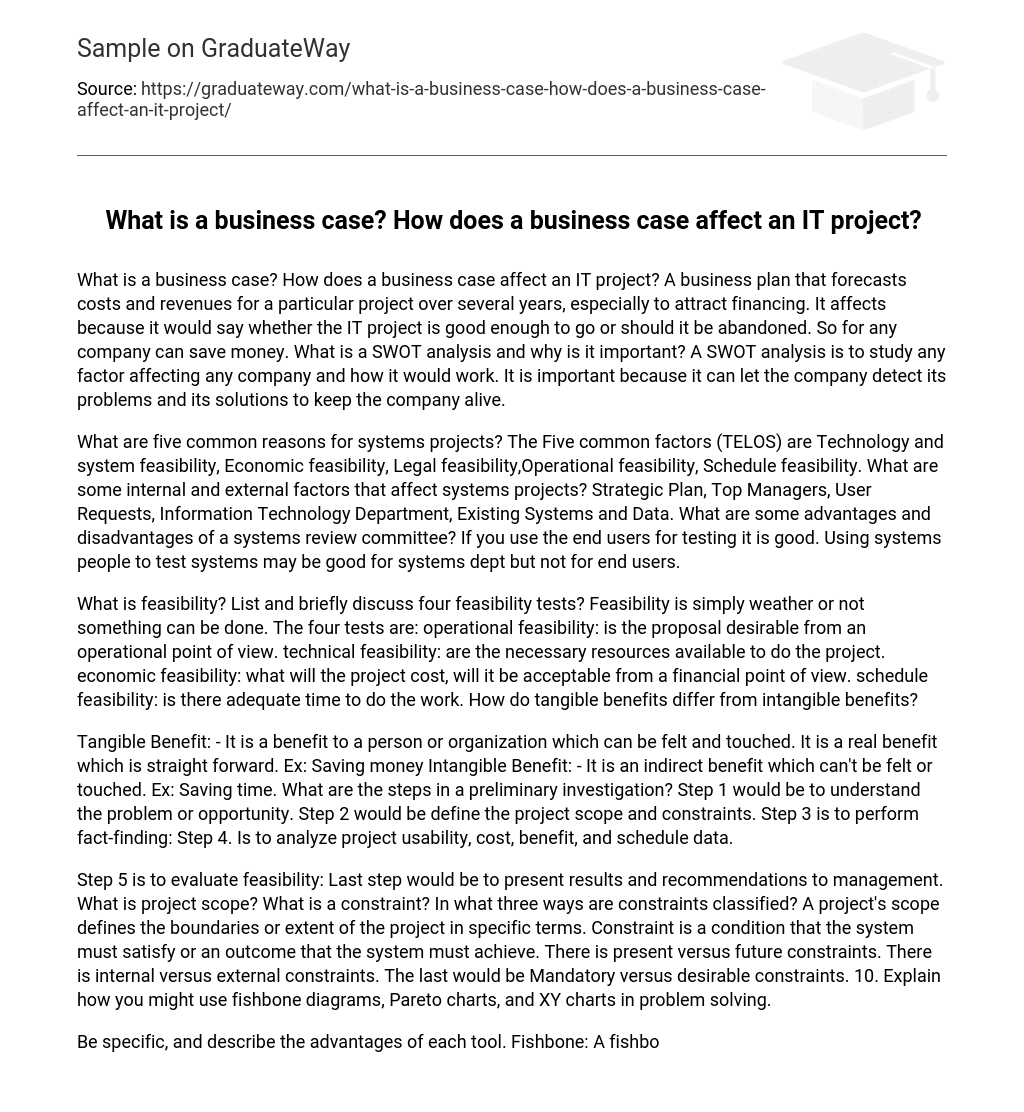What is a business case? How does a business case affect an IT project? A business plan that forecasts costs and revenues for a particular project over several years, especially to attract financing. It affects because it would say whether the IT project is good enough to go or should it be abandoned. So for any company can save money. What is a SWOT analysis and why is it important? A SWOT analysis is to study any factor affecting any company and how it would work. It is important because it can let the company detect its problems and its solutions to keep the company alive.
What are five common reasons for systems projects? The Five common factors (TELOS) are Technology and system feasibility, Economic feasibility, Legal feasibility,Operational feasibility, Schedule feasibility. What are some internal and external factors that affect systems projects? Strategic Plan, Top Managers, User Requests, Information Technology Department, Existing Systems and Data. What are some advantages and disadvantages of a systems review committee? If you use the end users for testing it is good. Using systems people to test systems may be good for systems dept but not for end users.
What is feasibility? List and briefly discuss four feasibility tests? Feasibility is simply weather or not something can be done. The four tests are: operational feasibility: is the proposal desirable from an operational point of view. technical feasibility: are the necessary resources available to do the project. economic feasibility: what will the project cost, will it be acceptable from a financial point of view. schedule feasibility: is there adequate time to do the work. How do tangible benefits differ from intangible benefits?
Tangible Benefit: – It is a benefit to a person or organization which can be felt and touched. It is a real benefit which is straight forward. Ex: Saving money Intangible Benefit: – It is an indirect benefit which can’t be felt or touched. Ex: Saving time. What are the steps in a preliminary investigation? Step 1 would be to understand the problem or opportunity. Step 2 would be define the project scope and constraints. Step 3 is to perform fact-finding: Step 4. Is to analyze project usability, cost, benefit, and schedule data.
Step 5 is to evaluate feasibility: Last step would be to present results and recommendations to management. What is project scope? What is a constraint? In what three ways are constraints classified? A project’s scope defines the boundaries or extent of the project in specific terms. Constraint is a condition that the system must satisfy or an outcome that the system must achieve. There is present versus future constraints. There is internal versus external constraints. The last would be Mandatory versus desirable constraints. 10. Explain how you might use fishbone diagrams, Pareto charts, and XY charts in problem solving.
Be specific, and describe the advantages of each tool. Fishbone: A fishbone diagram is an analysis tool that represents the possible causes of a problem as a graphical outline. When using a fishbone diagram, an analyst first states the problem and draws a main bone with sub-bones that represent possible causes of the problem and identifies four areas to investigate: environment, workers, management, and machines. In each area, the analyst identifies possible causes and draws them as horizontal sub-bones. For example, too hot is a possible cause in the environment bone.
For each cause, the analyst must dig deeper and ask the question: What could be causing this symptom to occur? For example, why is it too hot? If the answer is insufficient air conditioning capacity, the analyst indicates this as a sub-bone to the too hot cause. In this manner, the analyst adds additional sub-bones to the diagram, until he or she uncovers root causes of a problem, rather than just the symptoms. Pareto Charts: Pareto charts are a widely used tool for visualizing issues that need attention. A Pareto chart is drawn as a vertical bar graph.
The bars, which represent various causes of a problem, are arranged in descending order, so the team can focus on the most important causes. XY Charts (Scatter Diagrams): The XY chart , sometimes called a scatter diagram , is another problem-solving tool. Often, an analyst looks for a correlation between two variables. If there is no correlation between the variables than you would look elsewhere for the source of the problem. However, if it indicates a strong relationship between the variables then that information would be extremely valuable in the problem-solving process.





